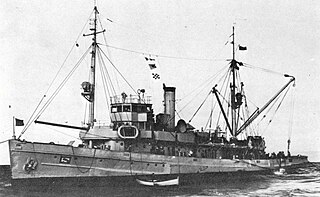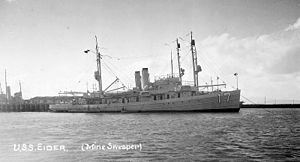USS Bobolink (AM-20/AT-131/ATO-131) was a Lapwing-class minesweeper acquired by the United States Navy for the dangerous task of removing mines from minefields laid in the water to prevent ships from passing.
USS Pigeon (AM-374) was an Auk-class minesweeper acquired by the United States Navy for the dangerous task of removing mines from minefields laid in the water to prevent ships from passing.
USS Swift (AM-122) was an Auk-class minesweeper acquired by the United States Navy for the dangerous task of removing mines from minefields laid in the water to prevent ships from passing.

USS Waxwing (AM-389) was an Auk-class minesweeper acquired by the United States Navy for the dangerous task of removing mines from minefields laid in the water to prevent ships from passing. She was the only U.S. Navy ship named for the waxwing, any of several American and Asiatic songbirds which are for the most part brown and are characterized by predominant crests and velvety plumage.

USS Towhee (AM-388) was an Auk-class minesweeper acquired by the United States Navy for the dangerous task of removing mines from minefields laid in the water to prevent ships from passing.

USS Owl (AM-2) was an Lapwing-class minesweeper acquired by the U.S. Navy for the dangerous task of removing mines from minefields laid in the water to prevent ships from passing.
USS Curlew (AM-8) was a Lapwing-class minesweeper acquired by the United States Navy for the dangerous task of removing mines from minefields laid in the water to prevent ships from passing.

USS Thrush (AM-18) was a Lapwing-class minesweeper acquired by the United States Navy for the dangerous task of removing mines from minefields laid in the water to prevent ships from passing.

USS Teal (AM-23/AVP-5) was a Lapwing-class minesweeper acquired by the United States Navy for the task of removing naval mines from minefields laid in the water to prevent ships from passing. The ship entered service in 1918, was converted into a seaplane tender in the 1920s and took part in World War II, serving primarily in Alaskan waters. Following the war, the ship was decommissioned and sold in 1948. Teal was named after the teal, any of several small, short-necked, river ducks common to Europe and the Americas.

USS Pelican (AM-27/AVP-6) was an Lapwing-class minesweeper acquired by the United States Navy for the dangerous task of removing mines from minefields laid in the water to prevent ships from passing.

USS Seagull (AM-30) was an Lapwing-class minesweeper acquired by the United States Navy for the dangerous task of removing mines from minefields laid in the water to prevent ships from passing.
The first USS Flicker (AM-70) was a minesweeper in the United States Navy during World War II, named after the flicker, a medium-sized member of the woodpecker family common to North America.
USS Sanderling (AM-37) was an Lapwing-class minesweeper acquired by the United States Navy for the dangerous task of removing mines from minefields laid in the water to prevent ships from passing.

The first USS Ortolan(AM-45/ASR-5) was a Lapwing-class minesweeper in the United States Navy. She was later converted to a submarine rescue ship. She was named after the ortolan, a European bunting.

USS Grebe (AM-43) was a Lapwing-class minesweeper in the United States Navy.
USS Engage (AM-93) was an Adroit-class minesweeper of the United States Navy. Laid down on 26 February 1942 by the Dravo Corporation, Neville Island, Pittsburgh, Pennsylvania, launched on 11 July 1942, and commissioned on 22 October 1942. The ship was reclassified as a submarine chaser, PC-1597 on 1 June 1944.

USS Sandpiper (AM-51) was a Lapwing-class minesweeper. Laid down on 15 November 1918 at the Philadelphia Navy Yard, Philadelphia, Pennsylvania, and launched on 28 April 1919, USS Sandpiper was commissioned on 9 October 1919, redesignated AM-51 on 17 February 1920, and reclassified as a Small Seaplane Tender, AVP-9 on 22 January 1936.
USS Opponent (AM-269) was an Admirable-class minesweeper built for the U.S. Navy during World War II. She was built to clear minefields in offshore waters, and served the Navy in the Atlantic Ocean and then was transferred to the North Pacific Ocean before war’s end.

USS Auk (AM-38) was a Lapwing-class minesweeper acquired by the United States Navy after World War I to remove mines that had been placed during the war.

USS Alecto (AGP-14) was a Portunus-class motor torpedo boat tender built for the United States Navy during World War II. She was originally ordered as USS LST-977 an LST-542-class tank landing ship, but renamed and re-designated on 12 June 1944.













